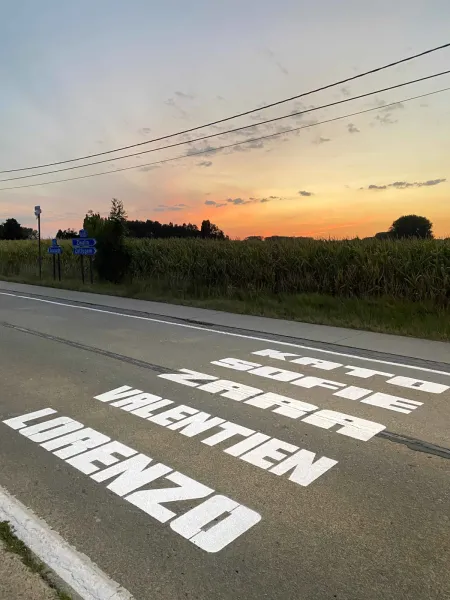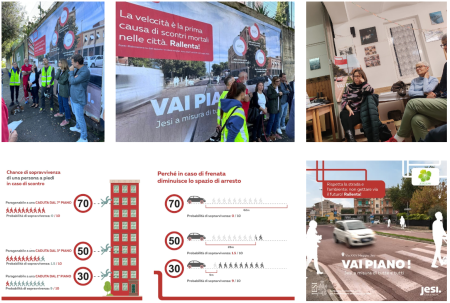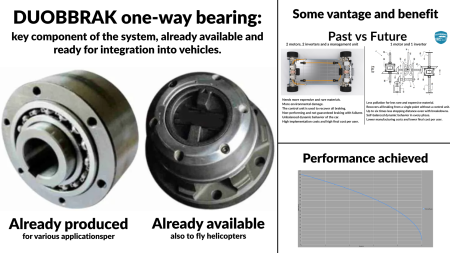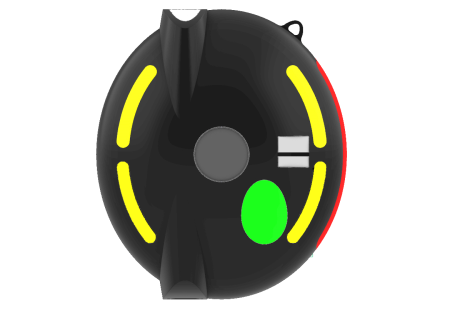Company employees

Friday, May 30, 2025
Our initiative addresses critical road safety challenges that are often overlooked in traditional driver education. Most driving schools focus on basic vehicle operation, but not on real-life risk anticipation, distraction management, or defensive mindset.
Key problems tackled by our VR Defensive Driving System include:
Driver distraction, especially due to smartphones and infotainment systems
Poor anticipation of traffic risks, particularly in urban and mixed traffic
Lack of situational awareness and understanding of the “big picture” around the vehicle
Insufficient consideration for other road users, including vulnerable groups
Specific risks related to pedestrians and cyclists, especially in city environments
Our project empowers drivers of all ages and experience levels to build mental habits that keep them and others safe – by learning to observe more, react earlier, and drive smarter.
Key problems tackled by our VR Defensive Driving System include:
Driver distraction, especially due to smartphones and infotainment systems
Poor anticipation of traffic risks, particularly in urban and mixed traffic
Lack of situational awareness and understanding of the “big picture” around the vehicle
Insufficient consideration for other road users, including vulnerable groups
Specific risks related to pedestrians and cyclists, especially in city environments
Our project empowers drivers of all ages and experience levels to build mental habits that keep them and others safe – by learning to observe more, react earlier, and drive smarter.

Friday, May 30, 2025
One of the key challenges in modern road safety is ensuring that driver assistance systems (ADAS) function reliably and accurately in real-world conditions. Among these, the Speed Limit Information Functions (SLIF), which display the current speed limit to the driver, are critical to encouraging compliant and safe driving behavior.
However, if these systems display incorrect or outdated speed information, drivers may unintentionally drive too fast or too slow for the road conditions, increasing the risk of collisions, fines, and public distrust in vehicle technology.
IVEX has developed an innovative platform that enables vehicle manufacturers and consumer testing organizations like Euro NCAP to objectively evaluate how well these systems perform on real roads, not just in simulations or controlled environments.
By enabling large-scale, real-world testing and providing quantifiable performance insights, IVEX helps:
- Manufacturers improve the reliability of their ADAS systems,
- Regulators and safety organizations set smarter standards,
- Consumers make informed decisions about the safety of their vehicles.
Ultimately, IVEX's solution contributes to:
- higher transparency,
- better engineering,
- fewer speed-related accidents.
Helping advancing Europe’s Vision Zero goals and making roads safer for everyone.
However, if these systems display incorrect or outdated speed information, drivers may unintentionally drive too fast or too slow for the road conditions, increasing the risk of collisions, fines, and public distrust in vehicle technology.
IVEX has developed an innovative platform that enables vehicle manufacturers and consumer testing organizations like Euro NCAP to objectively evaluate how well these systems perform on real roads, not just in simulations or controlled environments.
By enabling large-scale, real-world testing and providing quantifiable performance insights, IVEX helps:
- Manufacturers improve the reliability of their ADAS systems,
- Regulators and safety organizations set smarter standards,
- Consumers make informed decisions about the safety of their vehicles.
Ultimately, IVEX's solution contributes to:
- higher transparency,
- better engineering,
- fewer speed-related accidents.
Helping advancing Europe’s Vision Zero goals and making roads safer for everyone.

Friday, May 30, 2025
Cycling to work is sustainable, accessible, inclusive, low-cost, and healthy.
A mental shift – changing attitudes, perceptions, and habits – is essential before a modal shift can occur, because employees must first believe in the safety, practicality, and benefits of cycling before they are willing to change their daily transport choices.
We focus on the risks associated with cycling to work. Many employees lack the safety awareness and practical skills to navigate these challenges.
We identify three core road safety problems:
1. Distraction while cycling: using smartphones, GPS devices, or headphones significantly impairs attention and reaction time.
2. Inappropriate speed, particularly on electric bicycles: the higher speeds of e-bikes require better anticipation and control, yet many cyclists are unaware of the dangers this poses in mixed traffic.
3. Cycling under the influence: alcohol or drug use, even in small amounts, dramatically reduces a cyclist’s coordination and judgment.
These challenges are compounded by a lack of targeted, practical training for adult commuters. Our project uses immersive virtual reality simulations to allow employees to experience these risks in a controlled environment, raising awareness, changing perceptions, and promoting safer cycling behavior. The ultimate goal is achieving a mental and modal shift toward safer, more sustainable mobility choices.
A mental shift – changing attitudes, perceptions, and habits – is essential before a modal shift can occur, because employees must first believe in the safety, practicality, and benefits of cycling before they are willing to change their daily transport choices.
We focus on the risks associated with cycling to work. Many employees lack the safety awareness and practical skills to navigate these challenges.
We identify three core road safety problems:
1. Distraction while cycling: using smartphones, GPS devices, or headphones significantly impairs attention and reaction time.
2. Inappropriate speed, particularly on electric bicycles: the higher speeds of e-bikes require better anticipation and control, yet many cyclists are unaware of the dangers this poses in mixed traffic.
3. Cycling under the influence: alcohol or drug use, even in small amounts, dramatically reduces a cyclist’s coordination and judgment.
These challenges are compounded by a lack of targeted, practical training for adult commuters. Our project uses immersive virtual reality simulations to allow employees to experience these risks in a controlled environment, raising awareness, changing perceptions, and promoting safer cycling behavior. The ultimate goal is achieving a mental and modal shift toward safer, more sustainable mobility choices.

Monday, May 26, 2025
Road crashes is a major societal problem worldwide, especially in cities where pedestrians, cyclists and motorcyclists are highly exposed and vulnerable in case of a collision. The new policy of city-wide 30 km/h speed limit is intended to ensure vulnerable road users’ safety accounting for 70% of deaths in road crashes in urban areas in Europe.
Scientists urge continuously for lower speeds; however, speeding remains a model and sought behaviour among most drivers and riders, especially the young. The voices of vulnerable road users for less speeding remain weak towards our long-established car and speed-centred societies.
The National Technical University of Athens (NTUA) launched the innovative and original 30 Marathons in 30 months campaign (www.georgeruns30x30.com), aimed at promoting city-wide 30 km/h speed limit in all cities worldwide, as a key policy for safer, healthier and greener cities for all. The NTUA campaign was implemented by the internationally renowned NTUA Professor George Yannis, who is ranked 2nd in Europe and 9th worldwide in road safety science, and supported by the NTUA Road Safety Observatory (https://www.nrso.ntua.gr), a Centre of Research and Innovation Excellence on road safety with global recognition.
This impactful campaign represents a major shift towards a more human-centred approach to urban planning, where people are at the heart of design decisions.
Scientists urge continuously for lower speeds; however, speeding remains a model and sought behaviour among most drivers and riders, especially the young. The voices of vulnerable road users for less speeding remain weak towards our long-established car and speed-centred societies.
The National Technical University of Athens (NTUA) launched the innovative and original 30 Marathons in 30 months campaign (www.georgeruns30x30.com), aimed at promoting city-wide 30 km/h speed limit in all cities worldwide, as a key policy for safer, healthier and greener cities for all. The NTUA campaign was implemented by the internationally renowned NTUA Professor George Yannis, who is ranked 2nd in Europe and 9th worldwide in road safety science, and supported by the NTUA Road Safety Observatory (https://www.nrso.ntua.gr), a Centre of Research and Innovation Excellence on road safety with global recognition.
This impactful campaign represents a major shift towards a more human-centred approach to urban planning, where people are at the heart of design decisions.

Friday, May 2, 2025
Veilig Over is een initiatief dat ernaar streeft voetgangers veilig te laten oversteken en dat bovendien iedereen toestaat om ook zélf aan te duiden waar er nood is aan een veilige oversteekplaats, via een onlineplatform veiligover.be. Samen oversteken veilig maken, dat is de ambitie van ‘Veilig Over’. Dit doen we met een unieke samenwerking met lokale en regionale overheden & burgerparticipatie en citizen sciene & wetenschappelijke evaluatie (met Vias institute). Dit alles met als resultaat: de concrete verwezenlijking van een veilige oversteekplaats op het terrein!

Wednesday, April 16, 2025
Una delle sfide principali riguarda una cultura radicata che privilegia l'uso dell'automobile, scoraggiando l'adozione di mezzi pubblici e di trasporti alternativi. Questo comportamento si riflette in un mancato rispetto delle normative del codice della strada. Inoltre, c'è una scarsa attenzione verso la protezione degli utenti più vulnerabili, come pedoni e ciclisti. Questo atteggiamento compromette la vivibilità della città, che viene vissuta più come un luogo di transito che come uno spazio di incontro e socializzazione.

Thursday, April 10, 2025
Road safety in Europe and worldwide is still tragically compromised by a high number of accidents and avoidable loss of human lives.
This is compounded by the worrying frequency of vehicle recalls for brake problems, with over 3 million units affected in just two years (ANSA data), a symptom of an intrinsic vulnerability in current systems.
The dependence on rare materials in traditional braking systems and new technologies not only creates economic instability but also generates significant geopolitical implications.
Furthermore, there remains a lack of a reliable and universal mechanical solution capable of improving braking and ensuring safety in the event of failure.
These challenges highlight the urgent need for innovative solutions like DUOBBRAK, capable of overcoming the limitations of current systems, despite the resistance, and mostly the indifference, encountered in promoting it within the industry, accelerators, and public and private institutions
This is compounded by the worrying frequency of vehicle recalls for brake problems, with over 3 million units affected in just two years (ANSA data), a symptom of an intrinsic vulnerability in current systems.
The dependence on rare materials in traditional braking systems and new technologies not only creates economic instability but also generates significant geopolitical implications.
Furthermore, there remains a lack of a reliable and universal mechanical solution capable of improving braking and ensuring safety in the event of failure.
These challenges highlight the urgent need for innovative solutions like DUOBBRAK, capable of overcoming the limitations of current systems, despite the resistance, and mostly the indifference, encountered in promoting it within the industry, accelerators, and public and private institutions

Thursday, April 10, 2025
Guardrails installed on road bridges are essential to the safety of vehicles and road users. May accidents happen every year, involving vehicles falling from bridges with often fatal consequences. These issues have caused, in Italy, in the last decade, more fatalities than bridge collapses, even if we count the Morandi bridge collapse victims.
Many infrastructure managers, especially at the local level, often lack accurate and up-to-date inventories of the safety barriers on their bridges. Moreover, the limited availability of financial resources, combined with the lack of personnel, makes it difficult for these entities to effectively assess the condition of such critical infrastructure. This proposed technology is represented by an integrated methodology to automate the assessment of road guardrails installed on bridges using open-source data and deep learning (DL) algorithms. It innovatively uses YOLO (You Only Look Once) object detection algorithm to classify the safety barriers to establish whether they match the current standards. To speed up the evaluation process, the software tool involves the extraction of bridge information from OpenStreetMap (OSM) to construct a database of existing bridges, which most road management bodies miss. This is integrated with Google Street View API, for the extraction of images of each bridge’s safety barriers to be analysed by YOLO. The synergic concatenation of these three steps (OSM, Google Street View, YOLO) into a unique software tool, provides road managers with a cost-effective and efficient tool to remotely survey the guardrails installed on their bridges, permitting to timely identify bridges needing barrier replacment.
Many infrastructure managers, especially at the local level, often lack accurate and up-to-date inventories of the safety barriers on their bridges. Moreover, the limited availability of financial resources, combined with the lack of personnel, makes it difficult for these entities to effectively assess the condition of such critical infrastructure. This proposed technology is represented by an integrated methodology to automate the assessment of road guardrails installed on bridges using open-source data and deep learning (DL) algorithms. It innovatively uses YOLO (You Only Look Once) object detection algorithm to classify the safety barriers to establish whether they match the current standards. To speed up the evaluation process, the software tool involves the extraction of bridge information from OpenStreetMap (OSM) to construct a database of existing bridges, which most road management bodies miss. This is integrated with Google Street View API, for the extraction of images of each bridge’s safety barriers to be analysed by YOLO. The synergic concatenation of these three steps (OSM, Google Street View, YOLO) into a unique software tool, provides road managers with a cost-effective and efficient tool to remotely survey the guardrails installed on their bridges, permitting to timely identify bridges needing barrier replacment.

Friday, April 4, 2025
In 2022, 2.017 fatalities happened in the EU where cyclists have been involved representing 10% of all road fatalities.
More than 60% of all accidents between motor vehicles and bicycles occur when turning and crossing because bicycles are not illuminated from the side and the modern front and rear lights fitted emit a very focussed light that cannot be seen from the side.
The side reflectors, which are also mandatory, are only visible when they are illuminated.
For these reasons, both in bad weather and in the dark, bicycles are difficult or impossible to see from the side and are therefore often not noticed when they pass a car on the right-hand side, for example in front of traffic lights.
Bicycles are also difficult to recognise when crossing a road with oncoming traffic, as the multi-LED lights used on motor vehicles today shine much brighter than previous headlights.
Another problem is that car drivers do not keep the required minimum distance. Either because they are unable to judge the correct minimum distance or because they do not recognise bicycles in the dark.
Similarly, motorists are not made aware when they fall below the minimum distance and are therefore unable to react.
Intelligent, reactive lighting systems for bicycles are therefore needed in urban traffic to indicate to motorists the minimum distance to be maintained, warn them if the minimum distance is not observed and provide permanent side lighting for the bicycle.
More than 60% of all accidents between motor vehicles and bicycles occur when turning and crossing because bicycles are not illuminated from the side and the modern front and rear lights fitted emit a very focussed light that cannot be seen from the side.
The side reflectors, which are also mandatory, are only visible when they are illuminated.
For these reasons, both in bad weather and in the dark, bicycles are difficult or impossible to see from the side and are therefore often not noticed when they pass a car on the right-hand side, for example in front of traffic lights.
Bicycles are also difficult to recognise when crossing a road with oncoming traffic, as the multi-LED lights used on motor vehicles today shine much brighter than previous headlights.
Another problem is that car drivers do not keep the required minimum distance. Either because they are unable to judge the correct minimum distance or because they do not recognise bicycles in the dark.
Similarly, motorists are not made aware when they fall below the minimum distance and are therefore unable to react.
Intelligent, reactive lighting systems for bicycles are therefore needed in urban traffic to indicate to motorists the minimum distance to be maintained, warn them if the minimum distance is not observed and provide permanent side lighting for the bicycle.